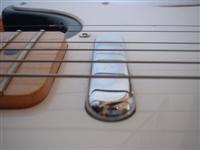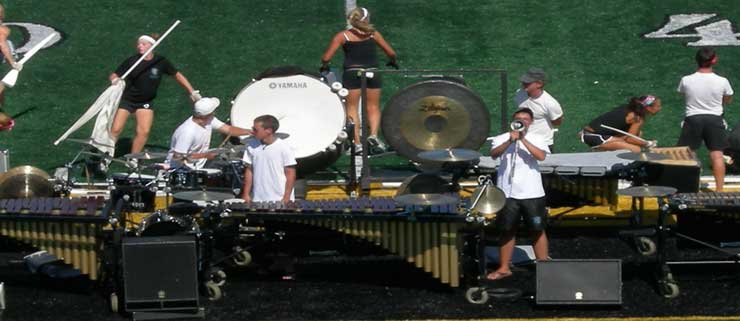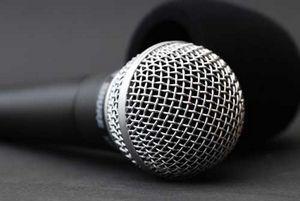 Worn strings are by far the most common cause of a bad tone and contribute to a lot of tuning problems. These simple tips will help you get the most out of your guitar.
Worn strings are by far the most common cause of a bad tone and contribute to a lot of tuning problems. These simple tips will help you get the most out of your guitar.
"How often should you change your guitar strings?"
Many guitar players leave the strings on their guitar until they break, but that really isn't recommended.
The strings are really the very life of the guitar!
Worn strings are by far the most common cause of a bad tone and contribute to a lot of tuning problems. These simple tips will help you get the most out of your guitar.
Guitar strings wear down because they are making metal to metal contact; that's the bottom of the string touching the top of the metal fret of the guitar.This causes wear on the underside of the string.
The string might look quite okay from above as you are looking down at the guitar, however on the underside of the strings, if you have a close look by rolling the string over a little bit, you will see little indentations forming on the underside of the string. That is where the fret has been rubbing against the string.
Eventually, things like acid from the perspiration of the guitarist's hands, rust, wax, grease, dirt and all these types of things change the diameter of the string. This means that the string cannot vibrate at the correct frequency.
So you can see there are a lot of variables involved; such as the climate and where you live. For example, if you live near the beach and you've got salt water and sea spray that will contribute to the string deteriorating rapidly.
Let's have a look at a few survival tips for strings.
Tip 1: WIPE YOUR STRINGS
One of the things that is really important is to wipe your strings down with a soft, dry, lint-free cloth. After you finish playing, just wipe the strings down on top and also get underneath the strings. In other words, put the cloth in between the strings and the fingerboard and run it all the way down the length of the neck of the guitar. This will help dry out the perspiration and clear off the rust and things like that.
Develop the habit of wiping your strings when you are finished playing for the day and your strings will feel great and last longer.
Tip 2: USE A STRING LUBRICANT
Here's another tip, particularly for new players because you may not know about this. There's a great product called Fingerease - it comes in an aerosol can, you simply spray it on your strings to reduce the friction between your fingers and the strings. It also helps protect the strings so they don't rust out as quickly as they normally would. It is an excellent idea highly recommended for players of all levels.
Tip 3: USE QUALITY STRINGS
The next tip is to always use a good quality string. All strings are not created equal.
Use a good quaility brand of string such as D'addario. They are very consistent, you put them on and they sound great first up.
Okay, let's move on to types of strings so you can determine which string suits your type of guitar.
STEEL STRING GUITARS: If you take a look at your steel-string guitar, the two thin strings are plain wire, they are just a straight wire.
On electric guitars, you will find the first three strings are plain wire. If you are playing an acoustic guitar, you will find the first and second strings, the two thin ones, are plain wire and then all the other strings are wound. The wound strings have a center core. That center core is just a straight, plain string like your thin strings with a wrap wire around it. Depending on what type of alloy they use on this wrap wire, it will give you a different tone.
Here are the three main types of strings you will find. There's the nickel-plated wrap wire. This provides a great overall tone and sound. It is probably the best selling type of electric guitar string in the last 50 years.
You can also get a stainless-steel wrap. This gives you an even brighter sound. They are generally used on electric instruments, but they can be used on acoustic guitars as well.
Then there are the phosphor-bronze strings these are recommended for acoustic guitars. They give you a full, rich, acoustic tone, a great, deep bottom end and nice, high, clear bell-like sounds on the high strings.
STRING GAUGES FOR ELECTRIC GUITAR: String gauges refer to the diameter of the string - for electric, I'd go for a nickel-wound string.
Gauges for nickel-wound string
First string 009/ Second string 011/ Third string 016/ Fourth string 024 /Fifth string 032 / Sixth string 042
Now I'd like to give you the string gauges that I use and recommend for acoustic guitar.
STRING GAUGES FOR ACOUSTIC GUITAR: First string 011/ Second string 015/ Third string 022 /Fourth string 032/ Fifth string 042 /Sixth string 052
NYLON-STRING GUITARS: If you are playing a nylon-string guitar, that means the first three strings will be clear nylon, I would recommend on the low three strings that are wound that you use silver-plated wound strings.
Here's another tip while we are talking about strings. Please don't put steel strings on a nylon-string guitar. Steel strings exert about 60 pounds or approximately 27 more kilograms more tension than nylon strings. That can do so much damage to your nylon-string guitar.
You can put nylon strings on a steel-string guitar, but it is not a great idea. A steel-string guitar is more heavily braced inside. When you put the nylon strings on it will essentially make the guitar sound very dull.
Another helpful hint is regarding the nut on the guitar. That is that white plastic part or it might be bone depending on which type of guitar you are playing. It is on the end of the finger board, right at the top and it holds the strings. It's got little grooves in it and that is what holds the strings in place.
A good idea to do there is to get a lead pencil and just rub it over the grooves so that some of the graphite will fall down into the groove. This is before you put the new string in.
The idea is that it will help the string slip and it won't get stuck in that groove when you are bending strings and so on. It will help the tuning of the guitar. It will help you get the guitar in pitch without hearing all those clicking sounds you often hear when you are putting strings on.
Now a fantastic accessory that professional guitarist's use and recommend is a STRING WINDER. These little devices don't cost much but, boy, they will save you so much time when you are changing your strings.
Mike Hayes is a guitar teacher, author, performing musician and session guitarist with over 30 years of professional experience. Mike's methods are legendary and have earned the praise of top authorities in guitar instruction. He reveals his guitar secrets at www.GuitarCoaching.com







 Scroll down to view the comparison chart of over a dozen different portable digital audio recorders.
Scroll down to view the comparison chart of over a dozen different portable digital audio recorders.